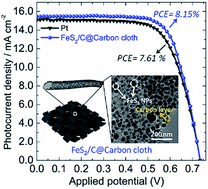FeS2/carbon hybrids on carbon cloth: a highly efficient and stable counter electrode for dye-sensitized solar cells†
Abstract
Low-cost, robust counter electrodes (CEs) with merits of superior catalytic activity and long-term stability, and rapid electron/mass transport are highly desirable for dye-sensitized solar cells (DSCs). Herein, FeS2/carbon hybrids on carbon cloth (FeS2/C@CC), in which FeS2 nanoparticles were embedded in a carbon shell, were fabricated using an in situ deposition–carbonization–sulfurization approach. The hybrid electrode can provide a rapid mass/electron transport rate at the electrolyte/electrode interface, revealed by electrochemical impedance spectroscopy and Kelvin probe force microscope measurements. Moreover, the in situ grown carbon shell not only guaranteed the tight adhesion of the hybrid catalysts to the substrate, but also contributed to the long-term stability and partly to the catalytic activity. As a result, the device with the FeS2/C@CC CE presented a power conversion efficiency of 8.15%, exceeding that of Pt (7.61%). The as-developed hybrid FeS2/C@CC electrode is a very promising candidate as a robust CE in DSCs. Meanwhile, the fabrication method could offer new opportunities in exploring high-performance catalysts for various energy-related applications.



 Please wait while we load your content...
Please wait while we load your content...